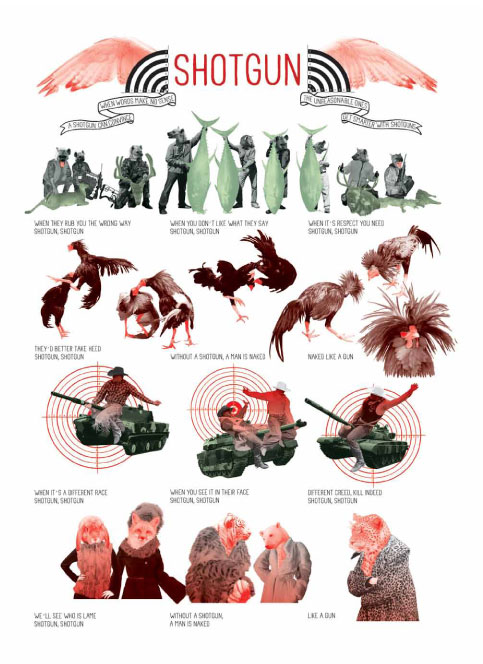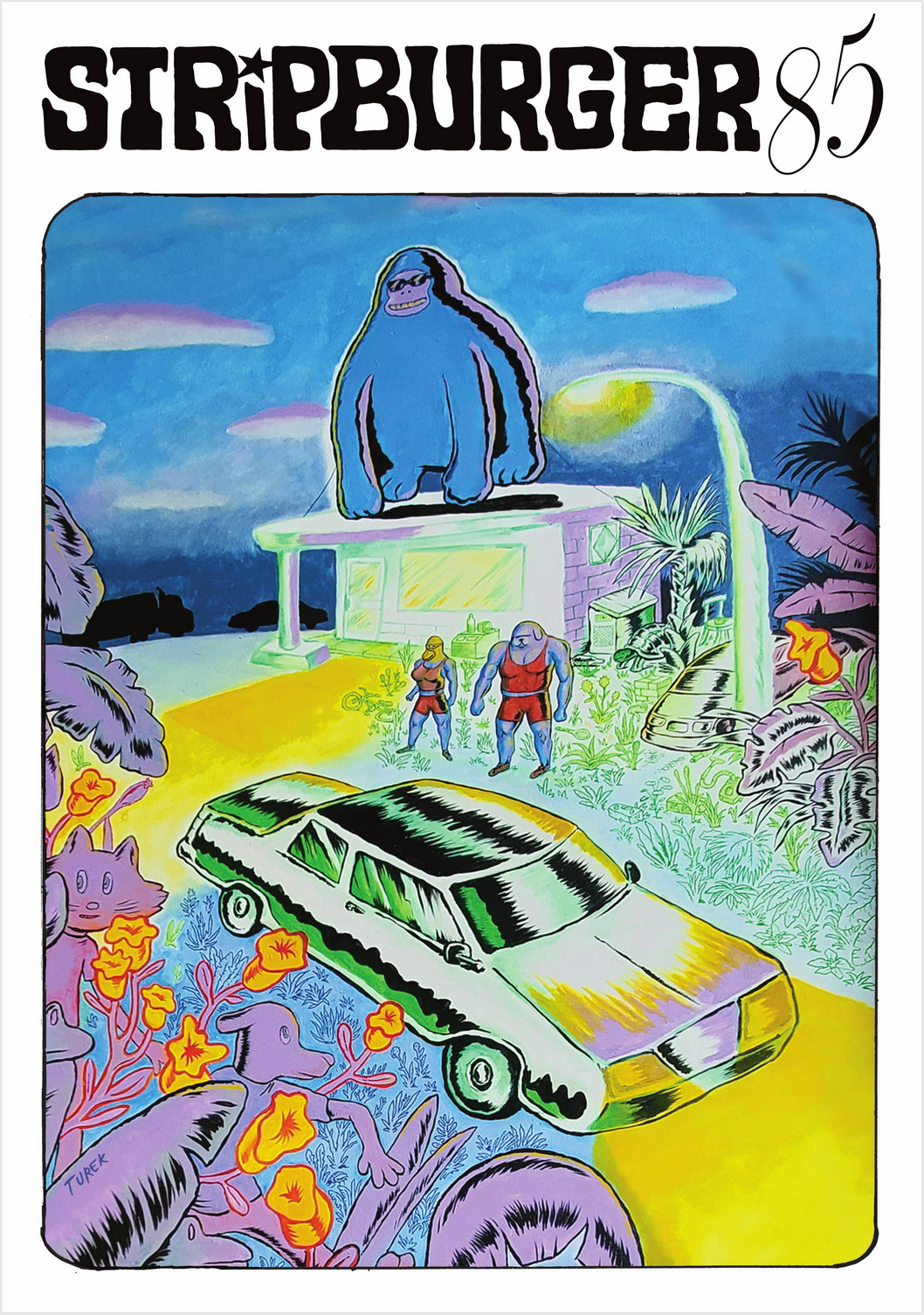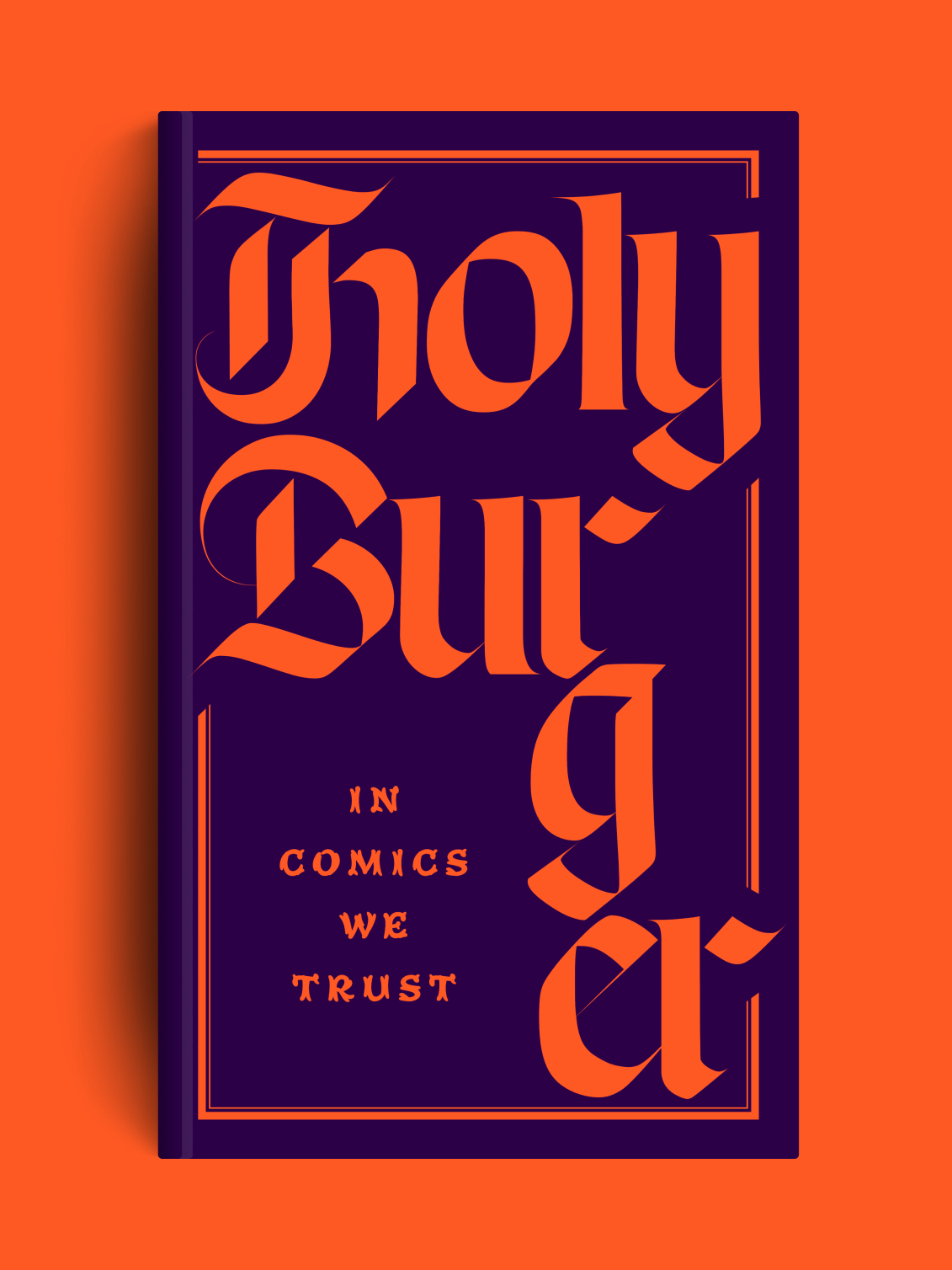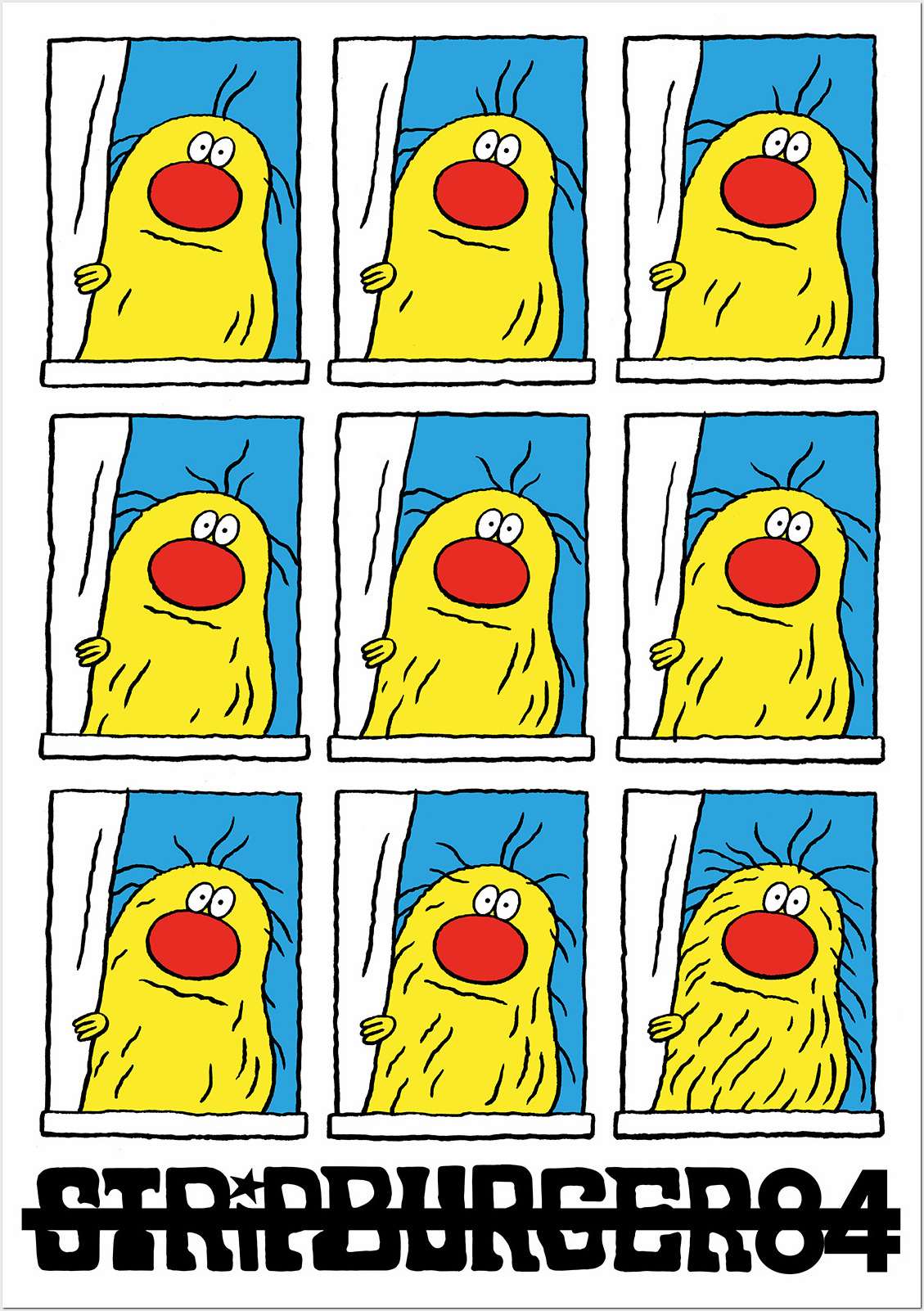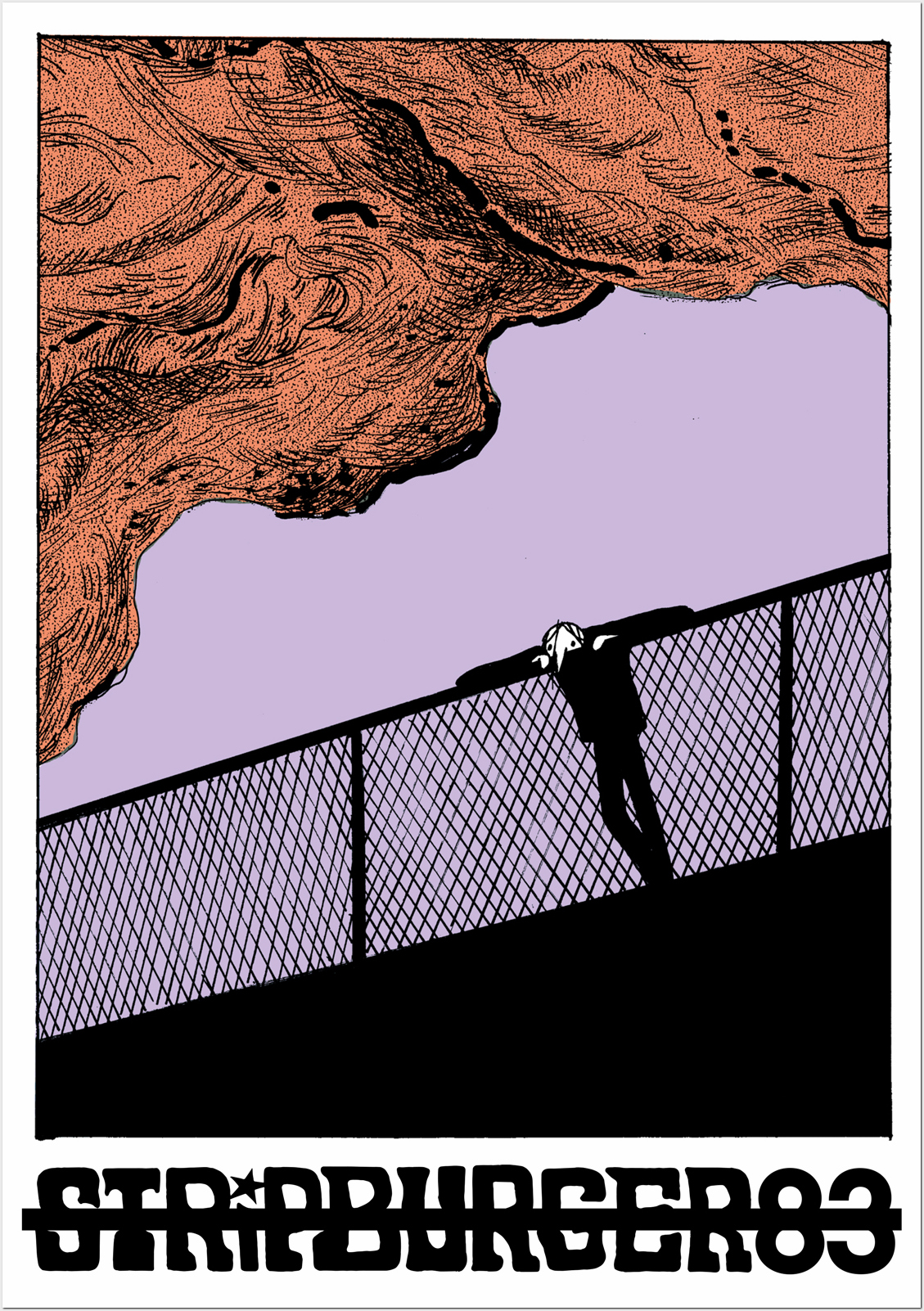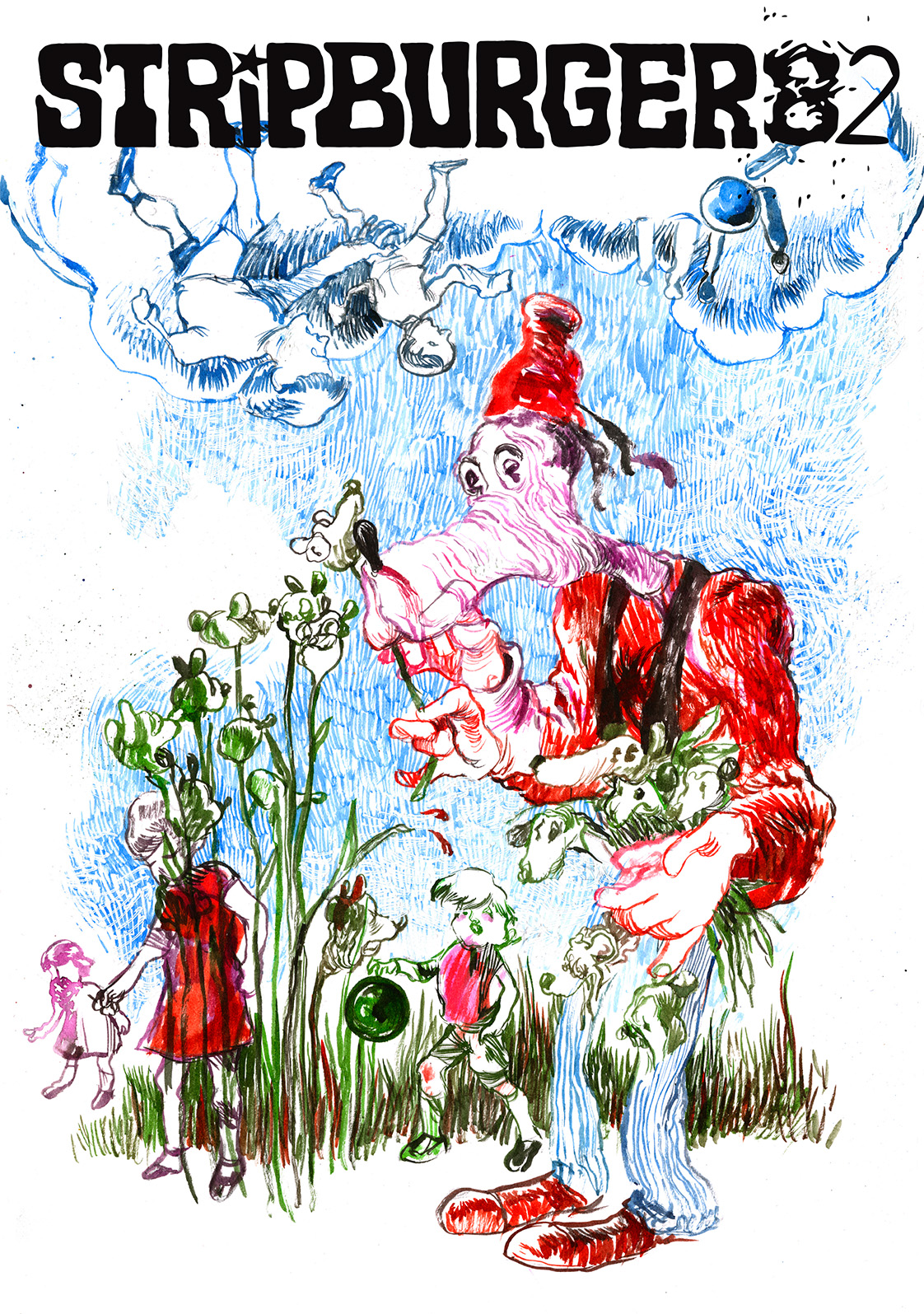Novo Doba (Serbia) – interview, Stripburger 57, June 2012
You probably already know that Stripburger’s connections reach in a tentaclesque manner all around the world. This is even more true for the comics scenes from the former common state of Yugoslavia. Despite formal and other difficulties they are still able to keep alive a vibrant shared cultural space that transcends the borders of the closed-minded national states. As it turns out, where there’s a lot of different languages in one place, the language is actually no obstacle at all.
Take for example the multinational crew of the international alter-kult festival Novo Doba (New Era) from Belgrade. This bunch of seemingly randomly assembled people is goofing around and annoying the domestic snobs and purists for the third year already. Novo Doba, the underground comics festival that now involves many other things as well, is an efficient insult to the common taste of the ignorant mob and at the same time its best representation.
Novo Doba platform were nagged by Bojan Albahari.
Who and what is the Novo Doba?
Radovan: Novo Doba is a friendly / cooperative group, a perhaps unconsciously-deliberately undefined ideological platform for the development of mutual interpersonal interaction in several different forms of active and peaceful coexistence – at this stage it is maybe most clearly associated with comic strip festival of the same name – but it seems like it is also linked to other similar parts of a larger whole. In this experimental phase, it may be useful to give it a name, assign it an appropriate definition or use some kind of neologism, so as to present it more clearly, at least on a formal level, to potential colleagues and friends; but the mere act of defining things has proven to be a great challenge to us from the very beginning of attempts to articulate this particular idea. This idea refers, as we have discovered, to some kind of (perhaps undefined, but still) feeling, as opposed to rational thinking, if you understand what we are trying to say, even though, we may be inclined to doubt it … or rather it refers to a situation in which emotion has priority over any specific thought or idea as such in the textbook meaning of the word, to stay on the topic.
Bruno: Novo Doba is at the same time a festival as well as an umbrella term for all other activities that fall under Turbo Comix, Fijuk and, soon, the Pionir magazine. These descriptions generated a whole mess, because the groups, initiatives and projects arose uncontrolledly; but it should be noted that when talking about Novo Doba, we are talking mainly about the comic strip scene, but also about one specific segment of the alternative scene in Serbia that we are trying to present through publications, exhibitions, concerts and similar events. The Novo Doba website should offer a more transparent picture of this structure; if such a structure exists at all, which we ourselves doubt.
How did you guys meet and come to the idea of creating a comic book team? The first mentioned is a Frenchwoman, the second comes from Croatia, the third is a Belgrade native …
Johanna: I came to Belgrade five years ago from the French Academy of Saint Etienne in on a student exchange. I was already working in comics back then, with the Gestroco club collective in Angoulême. As for comics, I was already aware of you and Alexander Zograf, whom I contacted when I arrived here. Through him, I soon came into contact with other comic writers, such as Wostok and Radovan. Then I had the idea of publishing a book in French about comics in Serbia and Croatia so I set up an association in France called Turbo Comix. In the meantime I met Bruno and together we moved Turbo Comix to Belgrade. We have been working with Raša (Radovan) constantly – the idea to organize a comics festival was his – and two years ago we began to cooperate with Mileta too, so that through this cooperation we expanded our activities to the fields of screen printing and music.
Radovan: One could say that the founders of Novo Doba are in fact groups that, unlike individuals, have been lurking around obscure parts of the underground culture, in particular those within urban areas, and especially in our fields of action, for an undetermined period of time. These are groups dealing with creation and with the recording of this creation, as well as with the reproduction of art works, including comics, books, music, posters, graphics, images, illustrations, designs, fanzines, albums, compilations, remixes, covers and homages, theft and copies, as well as video works, films, radio plays and shows, guitar solos, and almost anything except fashion. It could be said that there are more groups than individuals, which resists the law of history, but is not opposed to logic – make your own sums – of course it is possible in theory, mathematically at least, but now it is also implemented in practice. This is our small and modest contribution to the idea of a common goal and of associations formed with a noble purpose. In addition to the graphical activist Turbo Comix, the sound-landscape Klopka za pionira and the Studiostrip group, there are other collectives, individuals and components, heads, hands, eyes, ears and limbs in general. Our generation, whatever that means, did and still does consider it very important that a kind of tacit agreement brought forth the development of an impressive collaboration between various collectives, such as Komikaze and Yga, Entropija from Subotica, and of course the legendary Wostok team. In the eyes of our fans, Wostok is a great inspiration, moderator and father-figure; but since he has in the meantime become a grandfather, he is now more like a grandfather figure. One text is particularly popular in our circles – namely an essay on the domestic alternative comic strip scene from under the pen of one of the most influential personalities from the world of mainstream comics, entitled Gomila nadrogiranih manijaka teroriše srpsku strip scenu(A bunch of drugged maniacs terrorize the Serbian comic strip scene). The essay is excellent so we used it as a script template for a longer comic drawn by most of our active domestic non-commercial authors, which was published in a special number of the Krpelj fanzine, the most influential domestic publication.
Bruno: I would not say that Novo Doba is a collective – rather a platform. We joined forces encouraged by the circumstances and ideas that formed through our gatherings and which we thought attractive and relevant. I’m not so interested in the idea of a collective as much as I am interested in the possibilities offered by Novo Doba for the emergence of interesting creative personalities and groups of authors and for the promotion and consolidation of the so-called alternative scene.
Activities: in addition to comic books you are also involved in screen-printing, a graphic art genre not often associated with comics in this part of the world. How come you decided to expand your activities in this direction?
Johanna: I have already worked with screen-printing at school in France and for me it is quite significantly related to comic books – even more so with alternative comics, because there are many collectives engaging with this, such as Le Dernier Cri, Nicomix, Mathieu Desjardins, Allemane, Bongoût … Even before we started hanging out together, Mileta had already started with it, when the Le Dernier Cri and No Style Fuckers collectives from Berlin toured Pančevo. Then we started working together and recently we have opened a workshop in Pančevo.
Radovan: Studiostrip/Kosmoplovci, classified as senior individuals with regard to their age and habits, but also out of respect for the profession, are more reliant on older generation photocopying machines and inkjet printers; however, they also pay their dues to a wider range of possibly interested NN people with the printing technique of silk-screen printing through a series of catalogues, books and solo albums within the Studiostrip publications by the renowned Belgrade publisher Fabrika Knjiga, through their informative activist activity, which has also appeared in the media, and through the operation of the Beopolis bookstore, which was unfortunately – due to corporatist terror assaults in the form of constant reorganization and ignorunderstanding of cultural instances – removed and marginalized.
Bruno: Screen-printing is a traditional DIY technique that has always existed in the underground scene and which allows individuals with a small budget to print their own fanzines, posters and T-shirts, thus naturally complementing the activity of an industrious and creative underground enthusiast (shock-worker). Following the occurrence of photocopiers, many are now returning to screen-printing because it allows them flexibility, process control, quality of print and the possibility of simultaneous printing on paper, fabric and other surfaces.
Mileta: For a long time I have been trying to learn screen-printing; I made enquiries with the masters in the city, but I was always told that it is a very difficult and expensive process. When Klopka za pionira (Mileta’s music band, ed.) performed on the Stubnitz barge in Amsterdam, I was lucky enough to meet the No Style Fuckers team from Berlin. We only had four things: adhesive tape, a screen, squeegee and paint. Shortly after that at Fantom Fest in Pančevo I became acquainted with the work of Le Dernier Cri. I soon performed the first Ceger campaign in which I printed two works with a friend; Wostok’s corn and Kiklop’s eco comic. This is in some way the fulfilment of my boyhood dream: to wear a T-shirt that was the way you wanted it to be. Then I started to work with Johanna, the production was significantly improved, we started printing posters, stickers, books…
We last met when you had a workshop on posters for the club Menza pri koritu in Ljubljana. Do you often put on such things?
Johanna: We travel frequently and tend to put up a stand and / or exhibition – while workshops are rarer. The first workshop was organized two years ago, also at Metatisk printing at Metelkova with Igor Hofbauer, Bruno and I. We spent two days illustrating together of the Mileta’s text Tranziciona kupoprodaja (Transitional Wholesale) with the participants, and then three days screen-printing the book with the help of these drawings. This time, we were also assisted by the workshop participants in the printing process. The aim of these workshops organized by KUD Mreža is getting to know local artists and groups through Metatisk workshops that Metelkova has been hosting for several years. KUD Mreža, along with Matej Vukovič, who also runs a workshop at the Jarše School of Production, provided all that is needed for printing, and the workshop was open to all.
Bruno: Besides cluttering about comics, shopping bags and music releases, which we’re dragging about to all the events here and there if the opportunity arises, we also conduct a workshop or two, which can be either of the open variety, as was the case this time, or a spontaneous jam session with various authors, who find themselves in the area. I would like to add that the practice of collaborative working in Croatia and in Serbia was already present from the nineties onwards and represents a unique specificity in comparison to other comic strip scenes. The authors draw comics together based on selected texts from various sources (news articles, turbo folk songs lyrics, bad books, comic artists’ early poetry, confessions taken from online forums, etc.); sometimes also drawing on / over other artists’ work. As part of the Novo Doba festival we try to organise one single such workshop each time, with the help of one or more of the participants (Komikaze, Wostok).
Your music section is slightly reminiscent of the Stripcore collective, which also had its own band (2227). How does the Klopka za pionira place itself in your team and concept?
Mileta: Klopka za pionira belongs to an unseen scene, which cannot be defined as musical. Our only two guest appearances in Zagreb were connected with the festival of theatre and literature, we had our first concert at the comic strip festival, likewise for our first tour. Probably the reason for this is that the music is cheap entertainment, which is pushed out onto the rough capitalist market. At the actual Novo Doba festival, the connection between comic books, music and video is most evident and our programme represents this non-existent scene. Well, the term ‘scene’ is not actually the best choice, because it is more about individual cases, not included in the main streams, but existing independently on the periphery. It turned out that some of the bands are closer to comics than to music and vice versa. Soon we will publish the first musical issue for Novo Doba – Nitkov’s album Ako ne prekineš rizikuješ da ti se pridružim (If You Don’t Stop You Risk Me Joining You). Immediately following that will be the compilation Šta je bitno (What Matters), which will present the scene that we are creating to the public.
You are organizing your own Novo Doba underground comics festival in Belgrade this year for the third time. What made you decide to set up a project of such organisational complexity? Do you perhaps think that the underground comic scene in Serbia (Belgrade) is somewhat underweight and in need of such events? What are your experiences with the organization of comic strip festivals in general?
Johanna: This is Radovan’s idea. When I came to Serbia, followed shortly by Bruno, Zograf’s Grrr! festival was already over, but we liked the idea. First, we find it important to have an opportunity, which each year brings together authors from across the region. People mostly already know each other, either through Komikaze or Stripburger and various other publications and events, but we were missing an event that would bring together at least the majority of them in the same place at the same time. Another factor is that there are publishers and authors coming from abroad, whose work might be interesting to local authors and audiences who may thus become acquainted with the local production. With regard to experience with the festival, it seems to me that this has been a pretty ambitious idea for us in terms of our limited previous experiences, but one learns quickly when confronted with such an impressive amount of responsibilities at one time! Of course we are not professional organizers; we are doing it because we want this to happen, and since our guests supposedly know that, in the end everything is OK. The first year it was Raša, Bruno and I that organised it; the next year we were joined by Mileta – with the musical and screen-printing parts of the festival being thereby enriched –; while this year we have been joined by Anna Ehrlemark and Marija Samardžić. Now that there are more of us in the organisation everything is much easier – and we also receive help from other friends.
Radovan: Organising an event such as a comic strip festival, with more and more music, as well as film, is a difficult task, but extremely rewarding, because you have the opportunity to influence as much as possible that ‘something’ that is very hard to define. Nevertheless, the mere fact that here, at the same place and time, between summer and autumn, for the third consecutive year, gathers a monstrous bunch of people, so alike in their individual differences (people – not to use any heavier words – we all know the origin of humans), individuals who intertwine with comic strip characters answering the call to battle from the Dark Forest from the north, by the candle-light of eternal fire, says more than can be packed into any one definition or answer to the question of how, why and why not?!
Bruno: My experience is that one does such things because one wants them to happen; I cannot imagine that someone would genuinely want to be dealing with such matters. As you suggested, it seems to me that such things, in addition to web platforms, printed periodical publications and anthologies, are vitally important for any one scene, and that they should happen regularly.
You published a catalogue entitled Fijuk. What is the purpose of this publication and what does it contain?
Johanna: The Fijuk network is a project that is currently running. So far, we have had a first experience with it in Croatia, while we were on tour in Zagreb, Pula, Rijeka and Split and printing the catalogue. The aim of the network is to create a web platform for smaller publishers (music and comics), comic strip artists and musicians, whereby to gather as much information about them as possible, publish news about new releases and events related to comics and music. This website will be available very soon at www.fijuk.net. The first edition of Fijuk that you were able to read was a printed version of this site. We are also starting to publish various texts there (poetry, writings on comics, etc.), photographs and illustrations. We intend to set up a new magazine Pionir, which will be part of this project, as well as screen-printing workshops at various festivals (Škver in Mali Lošinj, Crack in Rome, Angoulême …)
Radovan: The Internet is full of beauty, but also of dangers (to freely quote Tarzan). The fact is that the information-activist activity almost completely moved from print to Internet, especially in the context of the general devaluation, privatisation and criminalisation and association for the purpose of criminal activity by the official print media; while we, on the other hand, have been inspired by this joy of separating the first grain from the weeds of information related to the field we are engaged and interests very few other people in the world beside us – which actually tells us that we must be on the right path – so this joy in combination with the pleasure that comes when we work, tear, cut, glue, copy, print, sniff printing ink, distribute, deliver, swap and share what the eye fancies, inspired us to start with Fijuk as a printed edition as well. The next step is the launch of a multi-dimensional and trans-avant-garde meta-psychical newspaper entitled Pionir. This is a big project, to which we all will totally devote our energies. We use such opportunities to transfer encrypted messages to groups and individuals who are willing and desirous, but also have the chance to be involved in creating a newspaper that will cover everything in terms of music, comics, film, therefore mainly street activities, phenomena, myths, information, curses, messages etc. in a completely new way.
Bruno: As Johanna already said, Fijuk is primarily a web-based project. In the future, it will appear in an abridged form in the newspaper-format magazine Pionir, which is in progress and for which we already have enough material for the first three numbers.
What are your side projects? We know, for example, of the fanzine Ceger (Mileta). Can you tell us more about this?
Radovan: All projects are ‘side’ projects. There is only one life, which is inconsistent with the dogmas of dominant religions, so it is a difficult and thankless task, and perhaps even uninteresting, if one were to enumerate all other side projects, such as the Kosmoplovci interdisciplinary team, in the context of which the idea of Studiostrip is maintained both in theory and practice, as well as through activism; the idea of a multi-purpose, multi-function group of mutually-related projects that are at the same time also closely connected with comics, as well as with all production phases of the medium: drawing, writing, deleting, falsification, journalism, comics theory in general, censorship, psychedelic properties and the like.
You are strongly associated with various authors and activists of the comic strip scene from the area of former Yugoslavia, but not only (Wostok, Igor Hofbauer, Dunja Janković, …). What brings you together and what do you have in common with those above-listed personnages?
Radovan: It is hard to say what it is that connects so many different people, different authors and schools from all over. Probably each participant interprets this connection in his or her own way and through a telescope, pointed in his or her own microscope. Personally, I see the relationship with these people as something that transcends certain determinants such as mutual respect, friendship and cooperation, or is just that, but in a much more immoderate fashion.
Bruno: A coalition with the aim to monopolise the market, encourage compatible neurotic disorders, homoerotic tensions, family practices, class struggle, collective masochism, the Stockholm syndrome …
I (we) have noticed that comics artists today are not just comics artists, but at the same time also designers, illustrators etc. Is it true also in your case? What does this mean to you (and why)? If so, why has it come to this? Is it the fact that one cannot live on drawing comics alone and therefore must also engage in other projects, or is it perhaps the case of modern identities, which are no longer monolithic, but a collage of various things?
Johanna: It is difficult to live on the production of an original comic strip alone anywhere in the world. Everyone else works on other stuff as well: illustration, design, Web design, animation, advertising, etc. I am, for example, a graphic designer, but I only rarely work in that area. It simply seems to me that you have to adapt, live at your parents’ or have an additional job if you want to engage in this field.
Radovan: From our Studiostrip perspective, working with comics, as well as other related and less related issues, reaches beyond concepts such as survival, work, earnings, or in other words, operating in this field alters the meaning of non-operating as such. We are where we are, the situation is what it is, and things can always be better and worse, in any situation. Consequently, in regard of where we are now and where we come from, what happened, is happening, what things are like and what they could be like, we experience what we do with deadly seriousness, fanatically, while at the same time working intensively on sabotaging this very seriousness through various self-harming techniques, experimenting on ourselves, playing tarot, giving each other extreme criticism, all in the direction of further death seriousness, leading to self-inflicted extinction and finally reaching refinement through a catharsis, leading towards the idea of an all-encompassing eternal ecstasy. Here the values of morality, tradition, religion, science, etc. change so quickly and radically that what today represents everything, tomorrow becomes nothing; two negatives make a positive, life-death-life, everything is incredibly important, as well as completely irrelevant, and vice versa, in proportion to the diametrically opposite, yet also different, trends in the same direction. It might sound a little complicated, but it is actually simplified to the limits of our own understanding. Outside experience has proved that it is extremely difficult to work with what you love and not compromise it in the process, while also being able to live on this work alone. Therefore we have never even tried, which does not mean that we believe that this is impossible. Our guerrilla mentality keeps us here at halfway, so we hold nothing against anything, and in principle we are for any cause, but we are also against it. Maybe we have overdone it a little in the sacralisation of a thing so mundane as form, in this case, the comic strip, but at least we have no explanation for it. This fanaticism may be caused by very different things, psychologically determined, de-genetic, unaesthetic, and so on; therefore not to enumerate them all here, we copy, invent, exaggerate, we lie, mystify… In theory, it is possible to live on comics, but the experience in practice is different; of course I have in mind this particular area here, when I say this. Comics are seriously drawn in garages, basements, children’s rooms, parks and cafes, or go to the other extreme and are created under logos, brands of transnational corporations or football clubs and local parties for five kopecks per hour, either way: the most important factor is that everyone complains. I think, hope, perhaps we are even working on it, that in a better future and a balanced, synchronized and comprehensive campaign, which implies all aspects and stages of creating a comic strip, it will be possible to engage with this such noble and beautiful art of the comic strip in a dignified way. An author is a Renaissance figure, who besides drawing the comic strip produces and places it, while at the same time feeling part of some kind of anthropomorphic global whole; (s)he reviews his / her work and that of others in a broader theoretical context, as well as in practice, with his / her own example, and with his/her unwavering focus on researching the unknown, re-understanding and redefining the familiar and unlimited faith in the ‘better tomorrow’ affects this ‘better tomorrow’.
Bruno: Through the work of organising the festival and various issuing projects, I began to notice that comic strip authors who interest me, have stronger bonds (aesthetic and of political attitudes, humour and general cultural characteristics) with the music and, for example, fanzine scenes than with the comic strip scene itself. I think we don’t share the same audience or the same market with the mainstream. Due to the nature of things, the festival must focus on the audience and mark the direction in which it is going to develop. Novo Doba has directed itself towards people who follow the underground scene, but also towards people who do not necessarily follow comics in general or, but tend to favour alternative, avant-garde and experimental art, regardless of whether it takes the form of film, music or paintings. This orientation has occurred both spontaneously, as well as being the result of practical situations and considerations. As we know, the reactions of the regular comic strip audience that is not favourable to underground comics, can be rather negative and aggressive (although sometimes quite funny), so I think our work should not be pushed to where there isn’t any interest for it or where there is even resistance to it; conversely, it is necessary to expand the network within the framework of a common cultural field. I think it’s only natural that a graphic artist, illustrator or writer decides to test his/her skills in comics. That may sound simplistic, but the comic strip is a narrative medium, just as illustration, film and to a large extent even music. On the other hand, it also has an important visual component; again, as do illustration, graphic art and painting. All these disciplines overlap with comics to a larger extent than this might be obvious. It is these overlaps that often hint at exciting new possibilities, generate new ideas and procedures, and this interaction is something I am personally very interested in. Of course, on the other hand, I also like an ‘honest’ classical comic. Experimental, avant-garde and underground comics are very important for the vitality of comics in general, although this is not so obvious on the surface.
What are your future plans?
Johanna: We are now preparing the third edition of the Novo Doba festival, which will be held from 5th to 10th June. As far as new guests are concerned, we are expecting the Belgian publishers Fremok, Aurélie Levaux and Moolinex, Léo Quiévreux, Mathieu Desjardins, the No Style Fuckers screen-printing mobile workshop from Berlin, Miro Župa, Valerio and Chantal from the Crack festival in Rome, Nataša Serec from KUD Mreža, Neven Korda… As for new releases, a book about the band Klopka za pionira entitledNervni gas iz zvučnika (Nerve Gas From Speakers) will be published soon, then the first issue of Pionir magazine and a catalogue of the Novo Doba festival. Regarding workshops: we will organise one at this festival, then another one at the Škver festival in Mali Lošinj (this year Škver takes place from 11th to 18th June) and then at the Crack Festival in Rome (between 21st and 24th June). In September, the workshop will return to Metelkova, then we are going to take it to Pula, in cooperation with the Croatian association Otompotom.
Radovan: The Spring-Summer season brings a series of fine premonitions towards a kind of universal connectivity and a perhaps undefined, yet common goal. Festivals follow each other tightly, from Novo Doba to Škver, Crack, Angoulême, Altcomics etc. There are some holes in this timeline, of which I am sure that authors will take advantage for their non-festival activity, whatever that means. A new issue of Turbo Comix … and some more inarticulate as well as organised events from the world of comics, audio, images, tone … They couldn’t pay us as much as we are working, but there is no compromise or middle ground or a line of least resistance, so that working with comics is beyond earthly relations and problems. Thus, it belongs to the fictional world, in the hope of scientific self-admission that would coincide with the next new age, the big global evolution, which, as the word itself suggests, evolves, i.e. is gradually going on and yet leads to a current realization of This Moment, which we are all expecting, whether we are aware of it or not, and that is, as each succeeding moment, all the closer and more inevitable.
Bruno: I want to emphasize the issuing of the Pionir magazine, which will include comics, music, prose, poetry, essays, critique and related disciplines. It is an attempt to give the scene, or more precisely, one aspect of the underground scene, its own periodical magazine, in which to publish and through which to develop. There will be room for journalism, criticism, ads, horoscopes, weather forecasts and the like. From my own experience I know that such a project is the best kind of stimulant for a limping scene, and the Serbian scene can be defined as such, when compared with its state of some years ago. When a periodical publication appears that regularly follows and publishes comics, people who have already given up the scene return to it and new agents appear. I personally think that this is perhaps the most important and most exciting future project, with which we are concerned.

